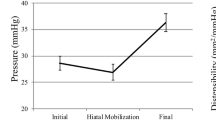Abstract
Background
Increased esophagogastric junction distensibility occurs with esophageal reflux. The EndoFLIP® is now available as a clinical tool to measure this. Control data for patients without reflux has to date only been available for a handful of patients evaluated under sedation during endoscopy. This study explores the baseline data for patients who undergo laparoscopy using general anesthesia with pneumoperitoneum.
Methods
Patients who require surgery in the absence of a history of esophageal reflux underwent EndoFLIP® evaluation of pressure, cross-sectional area, and distensibility with bag fills of 30 and 40 ml. This was performed after induction of anesthesia, during pneumoperitoneum, and just before extubation.
Results
Baseline levels were established and were noted to be significantly affected by the impact of pneumoperitoneum, with negligible effects from general anesthesia, patient gender, age, body mass index, or muscle relaxation.
Conclusions
These data provide a guide for more accurate intraoperative EndoFLIP® calibration of crural hiatal repair during surgery.






Similar content being viewed by others

References
Shaker R, Bardan E, Gu C, Massey BT, Sanders T, Kern MK, Hoffman RG, Hogan WJ (2004) Effect of lower esophageal sphincter tone and crural diaphragm contraction on distensibility of the gastroesophageal junction in humans. Am J Physiol Gastrointest Liver Physiol 287:G815–G821
Pandolfino JE, Shi G, Trueworthy B, Kahrilas PJ (2003) Esophagogastric junction opening during relaxation distinguishes nonhernia reflux patients, hernia patients, and normal subjects. Gastroenterology 125(4):1018–1024
Kahrilas PJ, Lin S, Chen J, Manka M (1999) The effect of hiatus hernia on gastro-oesophageal junction pressure. Gut 44:476–482
Kwiatek MA, Pandolfino JE, Hirano I, Kahrilas PJ (2010) Esophagogastric junction distensibility assessed with an endoscopic functional luminal imaging probe (EndoFLIP). Gastrointest Endosc 72:272–278
Kwiatek MA, Hirano I, Kahrilas PJ, Rothe J, Luger D, Pandolfino JE (2011) Mechanical properties of the esophagus in eosinophilic esophagitis. Gastroenterology 140:82–90
Acknowledgement
Disclosures
Drs. Leslie Nathanson, David Cavallucci, and Nathan Brunott have no conflicts of interest or financial ties to disclose.
Author information
Authors and Affiliations
Corresponding author
Rights and permissions
About this article
Cite this article
Nathanson, L.K., Brunott, N. & Cavallucci, D. Adult esophagogastric junction distensibility during general anesthesia assessed with an endoscopic functional luminal imaging probe (EndoFLIP®). Surg Endosc 26, 1051–1055 (2012). https://doi.org/10.1007/s00464-011-1996-3
Received:
Accepted:
Published:
Issue Date:
DOI: https://doi.org/10.1007/s00464-011-1996-3



